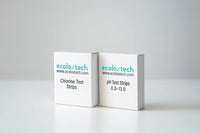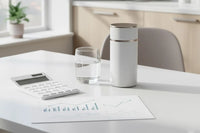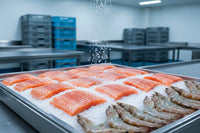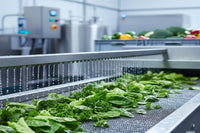In the high-stakes world of food production, where one microbial misstep can trigger national recalls and public backlash, sanitation isn’t just a checklist item—it’s the invisible wall between success and shutdown.
Every plant manager, sanitation lead, or food safety officer knows this pressure. You walk the line every day between operational efficiency, regulatory compliance, and biological warfare. On one side: your equipment, your workforce, your products. On the other: pathogens with names like Listeria monocytogenes, E. coli O157:H7, and Salmonella enterica—invisible saboteurs that can undo years of trust in a single contaminated shipment.
The default weapon of choice? Bleach. Chlorine-based sanitizers. Chemical cocktails that smell like danger and sting like regret.
But what if I told you that bleach—the go-to chemical in food sanitation for decades—is not just outdated, but actively harming your operation?
The Hidden Costs of Bleach: More Than Just a Sting in the Eyes
Let’s start with the obvious: bleach is effective at killing pathogens. That’s never been in question. But effectiveness comes at a cost - one that most food processors quietly accept as “the way things are.”
- Bleach is corrosive: to your staff, to your equipment, to your long-term operational health.
- It requires post-rinse cycles that waste thousands of gallons of water each week.
- It demands gloves, goggles, masks—layers of PPE that slow down workflows and create friction in every sanitation cycle.
- Bleach vapors continue to irritate lungs, burn eyes, and cause respiratory symptoms in frontline sanitation workers.
- Bleach’s effectiveness drops dramatically when organic matter is present—exactly the condition in almost every food processing environment.
So yes, bleach works… until it doesn’t. And when it doesn’t, the cost isn’t just equipment degradation or worker complaints. It’s pathogen outbreaks. It’s product recalls. It’s class-action lawsuits. It’s destroyed brand equity.
Nature’s Forgotten Weapon: What Is HOCl and Why Is It Different?
Now, imagine a molecule so effective that your own body uses it to defend against infection. A disinfectant produced by white blood cells during the immune response. One that’s non-toxic to humans, pets, and the environment—but instantly lethal to viruses, bacteria, fungi, and spores.
That molecule is hypochlorous acid (HOCl).
Unlike bleach, HOCl is non-corrosive, pH-neutral, and requires no rinse. It can be fogged into the air, sprayed on conveyor belts, misted directly onto produce, or used in dip tanks for seafood and poultry—all without the need for PPE or concern about chemical residue.
For decades, the challenge was producing HOCl in a stable and scalable form. But now, with advancements in electrochemical technology, companies like EcoloxTech have made it possible to generate HOCl on-site, on-demand, with just salt, water, and electricity. No drums. No storage. No transport. No risk.
Compliance Without Compromise
Let’s talk regulations. HOCl isn’t just a green alternative—it’s a compliance powerhouse.
- EPA: Listed on EPA’s List N (effective against COVID-19) and List K (approved for food contact surfaces in food facilities).
- FDA: Approved as a no-rinse sanitizer for produce and meat processing.
- USDA: Authorized for use in organic production.
- NSF D2: Certified for use in food processing environments.
HOCl checks every regulatory box that bleach does—and more. And it does so without creating downstream risks for your team or your customers.
Real-World Impact: What Happens When Plants Switch
This isn’t theory. Across the U.S., HOCl is being adopted in facilities that once swore by bleach. And the results are stunning.
- In a seafood processing plant in Florida, daily fogging with HOCl reduced microbial counts by over 90%, eliminating the need for harsh scrub-downs and reducing downtime between shifts.
- A USDA-inspected poultry processor in Georgia installed EcoloxTech’s Eco Max system and saw a 38% reduction in labor hours tied to sanitation—simply by removing the need for rinse cycles and PPE compliance checks.
- St. James Smokehouse reported eliminating bleach entirely and extending shelf life by 3–4 days on select product lines—boosting customer satisfaction and reducing spoilage rates.
In every case, the financial math worked: fewer chemicals, lower water bills, faster workflows, happier inspectors.
Beyond Cost Savings: The Human Factor
There’s a psychological element to HOCl adoption that often goes unspoken but is critical to understanding why this shift is happening.
Bleach smells like risk. Every worker who’s ever lifted a drum of sodium hypochlorite knows this. It burns your throat. It fogs your eyes. It feels like something you shouldn’t be handling.
HOCl doesn’t carry that burden. It has no scent. No sting. No risk of respiratory damage. When sanitation staff no longer dread their job—when the air is safe to breathe, and the gloves can come off—something remarkable happens:
- Morale goes up.
- Turnover goes down.
- Productivity increases.
While hard to price exactly, these compound effects show up in every audit, every employee review, and every retained contract.
Why Most Plants Haven’t Switched (Yet)
If HOCl is this powerful—this safe—why isn’t every food plant in America already using it? Simple: inertia.
The sanitation industry runs on legacy protocols, supplier contracts, and fear of change. “This is what we’ve always used” is a dangerous phrase in any safety-critical environment, yet it echoes through facilities every day.
There’s also a false belief that HOCl is expensive or unstable. Modern generators like those built by EcoloxTech have solved the stability issue through precise electrochemical control. When you factor in rinse water costs, PPE, corrosion-related downtime, and compliance management, HOCl systems often pay for themselves within months.
The Next Step: HOCl Generators for Food Plants
EcoloxTech offers a line of commercial-grade HOCl generators designed for specific plant sizes and sanitation demands:
- Eco One (240L/day): Ideal for smaller facilities or QA labs.
- Eco Pro (300L/day): Perfect for RTE lines, mid-size processors.
- Eco Max (1200L/day): Built for industrial-scale sanitation needs.
Each system integrates easily with your current sanitation protocols—no overhaul required. Many facilities run bleach and HOCl side-by-side during transition, quickly realizing that the old system is the liability.
The Truth You Can’t Ignore
The world is moving on from bleach. OSHA knows it. The FDA knows it. The smartest sanitation leads in the industry know it.
HOCl is not a trend. It’s not a greenwashing gimmick. It’s a paradigm shift. And if you’re still relying on corrosive chemicals to protect your product and your people, you’re not just taking a risk… you’re making a mistake.
Ready to See the System in Action?
👉 Download our free HOCl Compliance Pack to explore:
- Side-by-side comparison: Bleach vs HOCl
- USDA + FDA documentation checklist
- Real-world ROI calculators
- Approved HOCl usage protocols for produce, seafood, poultry, and RTE
📩 Delivered instantly. No fluff. Just clarity.





